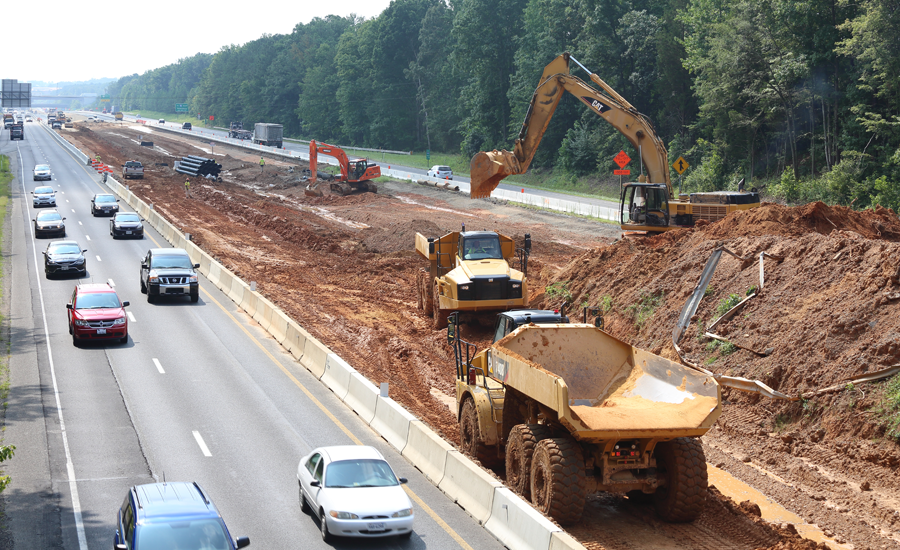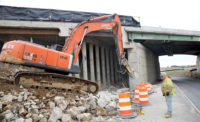State transportation officials and construction contractors are eagerly awaiting word from the Federal Highway Administration about how the agency will parcel out to states an estimated $2.1 billion in earmarked but long-unused highway-project funds. FHWA should make its announcement this month, an agency official says.
The fiscal 2016 omnibus appropriations measure, signed into law on Dec. 18, directs FHWA to redistribute to states unobligated funds earmarked for highway projects in transportation legislation dating back at least a decade. For example, some of the earmarks were contained in the Transportation Equity Act for the 21st Century, which was enacted in 1998.
The appropriations law specifies that states must redeploy the funds on a project within 50 miles of the old earmarked one.
Jim Tymon, American Association of State Highway and Transportation Officials chief operating officer, says, “The exact figure is somewhat of a moving target.” He adds, “Everything that we’ve seen out of FHWA preliminarily indicates it’s about $2.1 billion.”
Tymon adds, “There’s certainly a lot of interest among the states. I mean, if you put $2 billion out there, the states are certainly going to find every opportunity available to them to use it.”
FHWA spokesman Doug Hecox said via email, “This process is taking some time because we need to validate what is turning out to be a very long list of qualifying earmarks to ensure that we have an accurate, complete set.”
Hecox said, “FHWA is currently finalizing those determinations and we should have something to announce [this] month.” He said a spreadsheet listing the projects and funding should be available within about two weeks.
Brian Deery, senior director of the Associated General Contractors of America’s highway and transportation division, says, “Federal Highway told me that they had [about] 6,700 earmarked projects that they have a spreadsheet on that they have been following all these years.”
Deery notes, “Typically when a member of Congress earmarks the money, the language usually says, ‘This money is available until expended’—which is the big issue.” He adds, “You’ve got all this money sitting there in the ‘bank’ that can’t be used because, for one reason or another, the state or the locality didn’t decide to move forward with that project.”
He says, “There’s all kinds of reasons why that money didn’t get expended.” For example, an earmarked project may not be on a state DOT’s priority list, state officials’ plans may have changed since the earmark was created, or the original funding allocation may have fallen short of the amount needed to carry out the work, he notes.
It’s unclear whether FHWA will put further restrictions on the type of projects on which states can reuse the formerly earmarked dollars. In general, federal-aid highway funds can be used not only for roads but also for other types of infrastructure, such as bridges or bicycle and pedestrian paths. Some highway aid even can be shifted to transit projects.
The amount of repurposed money may vary greatly from state to state. In looking at earlier FHWA earmark lists, Deery says, “There are some states that have just a pittance.” He notes that Colorado has just $10,000 available, according to a March 31, 2015, document.
On the other hand, Deery says, North and South Carolina may be in line for much more. According to the March 31 FHWA list, North Carolina would receive $41.8 million and South Carolina $31.9 million, ENR calculates. Deery says, “That’s a significant boost in funding on top of the … boost we got in the FAST Act, particularly for 2016.”
The five-year, $305-billion Fixing America’s Surface Transportation Act, signed into law on Dec. 4, hikes the overall highway obligation ceiling by a strong $2.1 billion, or 5%, in fiscal 2016, according to the American Road & Transportation Builders Association.
Deery recalls, “They’ve tried to clear the books [on unused earmarks] a couple of times over the years and they always get pushback from states and from members of Congress.” He adds, "So this was a way of kind of making everybody happy. And I think it was also Congress looking at it and saying, ‘How else can we boost funding into this program?’ and that was a way to do it.”
When FHWA releases the old earmarked money, construction industry firms will be monitoring how rapidly state departments of transportation transfer it to new projects or to continue funding for jobs already underway.
Hecox says states would have to obligate the returned earmark money within three years. AGC’s Deery notes, “And of course, just like all federal-aid highway projects, even though the money gets obligated now, it doesn’t all get spent in the first year. It gets spent down over several years.”
AASHTO’s Tymon says, “This $2 billion has a few more strings attached to it than the money that normally goes out through the [highway] program on a yearly basis. But I think states will still act fairly quickly to get this money out the door.”




Post a comment to this article
Report Abusive Comment